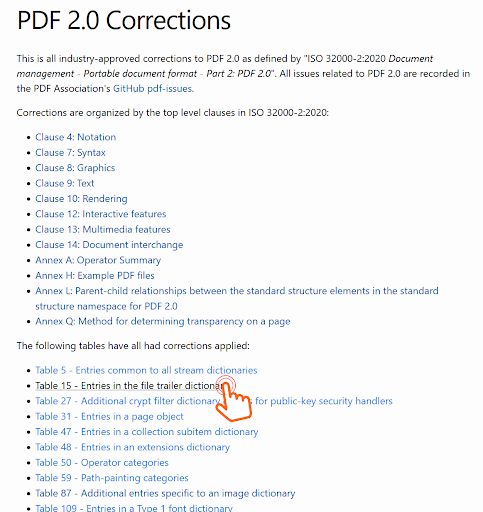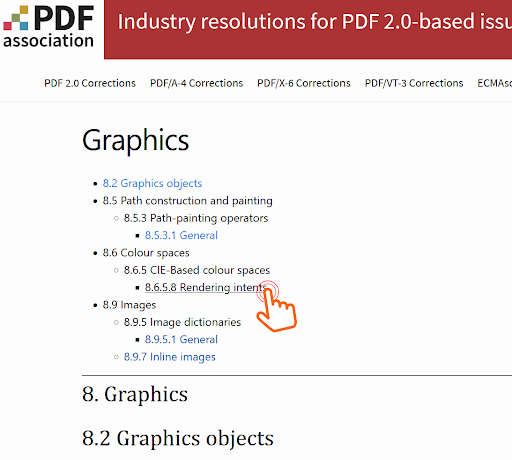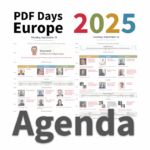PDF 2.0 corrections now easier to use

A developer and researcher working on PDF technologies for more than 20 years, Peter is the PDF Association’s CTO and an independent technology consultant.


BUSINESS NOTE
PDF is a modern evolving technology, so corrections and clarifications to PDF’s specification are a fact of life. Implementing errata resolutions ensures PDF software is both correct and interoperable to the greatest degree possible.
As I have previously announced, the PDF Association has an industry-centric errata correction process for all PDF 2.0-based ISO standards. This includes the core PDF 2.0 specification (ISO 32000-2:2020), PDF/A-4, PDF/X-6, PDF/VT-3 and ECMAscript for PDF 2.0. With 100 closed issues in GitHub, the quantity of industry-approved corrections is becoming more difficult to navigate efficiently.
Based on feedback from industry, the https://pdf-issues.pdfa.org/ area has been redesigned to add a number of usability improvements. A key change is that all resolved errata are now published via a dedicated custom subdomain of pdfa.org.
A quick access top menu will directly take you to errata for each PDF 2.0-related standard while the main title returns you to https://pdf-issues.pdfa.org/.

When you hover over a correction, whether it be an addition and deletion, a popup will appear with an active link to the specific GitHub Issues related to the correction - and, yes, there can be multiple issues for a single change. This allows the more technically minded to directly link back to previous discussions and gain insight as to the background reasoning behind each correction:

These popup links will also be displayed inline just before each change when errata pages are printed (note that the final printed appearance is somewhat dependent on your browser support for CSS media queries).
The main landing page for each ISO standard now includes an index of all Tables in the relevant standard that have resolved errata. For PDF 2.0 (ISO 32000-2:2020) especially, these tables are often a primary focus and well-known by developers as this is where each key of each PDF object are defined, so rapidly identifying corrections is extremely helpful:

The top of each main clause’s page now includes a local Table of Contents with clause headings leading to corrected areas, providing a far more structured overview of where corrections have been applied:

The website now also supports better accessibility, through the use of the HTML del and ins tags, improved color contrast, and overall better navigation.
The website improvements also now include the ability to directly reference an industry recommended resolved errata in code or other documentation via fixed URLs. Resolutions are published as a set of static URLs at https://pdf-issues.pdfa.org/ where each URL has the form <standard-number>/clause<clause-number>.html. Each of these resolution pages now also includes anchor points for all clause Headings (#Hx.y.z anchors to heading X.Y.Z in the appropriate ISO standard) and Tables (#TableXXX anchors to Table XXX in the appropriate ISO standard). This allows very precise linkages to final resolution outcomes, without lots of scrolling.
For example:
- https://pdf-issues.pdfa.org/21757-1-2020/ links directly to every resolution in ISO 21757-1:2020 ECMAscript for PDF 2.0.
- https://pdf-issues.pdfa.org/32000-2-2020/clauseAnnexQ.html links directly to all resolutions in Annex Q (normative) Method for determining transparency on a page of ISO 32000-2:2020 (PDF 2.0).
- https://pdf-issues.pdfa.org/32000-2-2020/clause12.html#H12.5.6.5 links directly to all resolutions in ISO 32000-2:2020 (PDF 2.0) clause 12.5.6.5 Link annotations.
- https://pdf-issues.pdfa.org/32000-2-2020/clause08.html#Table87 links directly to all resolutions in ISO 32000-2:2020 (PDF 2.0) Table 87 - Additional entries specific to an image dictionary.
I hope these small improvements can help ease the burden for all PDF developers who need to constantly check for relevant corrections in order to maintain their technologies and ensure interoperability.




